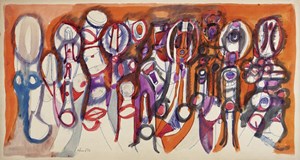
Avinash Chandra, a luminary of Indian modernist art in the post-independence era, emerges from the shadows of time as a forgotten master. One of the first Indian artists to attain international acclaim, Chandra's legacy has faded from the forefront of art discourse.
His profound contributions to the artistic realm, characterised by a vibrant amalgamation of abstraction and tradition, deserve renewed recognition.
Born on August 28, 1931, in Simla, Avinash Chandra embarked on his artistic journey by studying painting at Delhi Polytechnic. Commencing his artistic journey as a landscape painter, Avinash Chandra swiftly garnered acclaim for his evocative depictions of hills and mountains, even during his tenure as a student at Delhi Polytechnic.

Untitled, 1969, Mixed media on paper
However, a pivotal transformation marked the late 1950s, as his artistic style experienced a notable evolution. During this period, Chandra introduced abstract organic forms and sensual motifs into his repertoire, signifying a profound shift in his creative approach.
Despite garnering acclaim through two successful Indian exhibitions, Chandra found himself discontented with the domestic art scene. Consequently, in 1956, he migrated to the United Kingdom, accompanying his artist wife, Prem Lata, who was pursuing studies on a scholarship. Before settling in London, he extensively explored the United States and Europe, imbibing the styles of Vincent van Gogh and Chaïme Soutine, which profoundly influenced his European cityscape-inspired works.
Throughout his artistic odyssey, Chandra's recurring motif centred on the female form. His early elegant line drawings matured into implicit, coloured depictions of sensuality during the 1970s. Though sexuality played a role, it was part of a broader contextual tapestry. Employing primitivism, he distilled female anatomy into shapes suspended in a realm intermingled with phallocentric elements.
While the unmistakable echoes of Picasso and Paul Klee reverberate through his creations, Avinash Chandra retained a deep-seated connection to his roots. The opulent sensuality that graced his later works found its source in tantra and diverse Eastern philosophies. Interestingly, these seemingly
disparate cultural streams were intricately interwoven in his art, a testament to an imagination enriched by the finest aspects of both realms and their inherent principles.

Untitled, Oil on canvas
By tracing Chandra's evolution from his early urban landscapes to his exploration of the profound enigmas within the human form, a nuanced paradigm shift becomes evident. The measured audacity that characterised his initial years, with a poised and controlled palette, seems to yield to unbridled spontaneity, where brushstrokes waltz freely and lines whirl with fervour. An inclination to transcend geographical confines surfaces—whether in capturing the chaotic essence of an Indian metropolis or the expansive vistas of a Western city—to delve into the universal essence of the human physique. With time, Chandra's artwork captures torsos in myriad poses: contorted beyond recognition or fused with an intensity surpassing that of intimate passion.
Chandra's legacy includes being the inaugural Indian artist showcased at the prestigious global art event, Documenta in Kassel, West Germany, in 1964. His works became sought-after acquisitions, notably by UK museums. The 1960s brought him fellowships from the John D. Rockefeller III Fund and the Fairfield Foundation.
Image on top : Untitled, 1962, Waterproof ink, pen and ink on mount board
Authored by Sneha Gautam, Senior Vice President at AstaGuru Auction House.

ArtDependence Magazine is an international magazine covering all spheres of contemporary art, as well as modern and classical art.
ArtDependence features the latest art news, highlighting interviews with today’s most influential artists, galleries, curators, collectors, fair directors and individuals at the axis of the arts.
The magazine also covers series of articles and reviews on critical art events, new publications and other foremost happenings in the art world.
If you would like to submit events or editorial content to ArtDependence Magazine, please feel free to reach the magazine via the contact page.